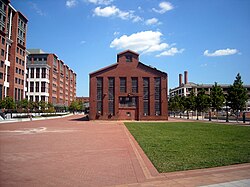Building 170
Building 170 | |
 Building 170 at Tingey Plaza. The U.S. Department of Transportation headquarters is visible on the left. | |
| Location | 3rd and Tingey Streets, SE Washington, D.C., United States |
|---|---|
| Coordinates | 38°52′29.62″N 77°0′7.41″W / 38.8748944°N 77.0020583°W |
| Built | 1919 |
| Architect | Unknown |
| Architectural style | Colonial Revival |
| Part of | Washington Navy Yard Annex Historic District (ID07001356) |
| Designated CP | January 3, 2008[1] |
Building 170 is a former electrical substation located by the Anacostia River in the Navy Yard neighborhood of Washington, D.C.. It is situated on the northwest corner of 3rd and Tingey Streets, Southeast, three blocks from the historic Washington Navy Yard. The industrial, two-story building was recently renovated and currently owned by the United States Department of Transportation. It is a contributing property to the Washington Navy Yard Annex Historic District, listed on the National Register of Historic Places in 2008.
History
Constructed in 1919, Building 170 was part of a 60 acre (24.2 ha) industrial complex used by the United States Navy until 1962. During World War I and World War II, the Navy Yard Annex was the center of U.S. naval weapon production and ordnance technology.[2][3] In 1963, ownership of Building 170 and 55 acres of the Washington Navy Yard Annex was transferred to the General Services Administration.[4]
The GSA completed a master plan to redevelop the site for office and mixed use to accommodate federal agencies, and to renovate and adapt some of the historic buildings. It conducted a design charrette in cooperation with the National Endowment for the Arts and nationally known designers, to generate more ideas for the site. It was a model for interagency charrettes, later used by the departments of Treasury and Agriculture, among others.
In 2006, Building 170 was renovated when the U.S. Department of Transportation built its new headquarters on the same street. Upgrades to the surrounding property included the installation of fountains, landscaping, and a plaza.[5] Future plans for the renovated building include leasing 8,000 square feet (740 m2)* of retail space on the first floor, with the second floor's remaining 10,500 square feet (980 m2)* being leased if demand rises.[6][7][8][9]
On January 3, 2008, Building 170 was one of 14 structures designated as contributing properties to the Washington Navy Yard Annex Historic District. The boundaries of the historic district include M Street, the Anacostia River, Isaac Hull Avenue, and 2nd Street, SE.[1][2][5]
Architecture
Building 170 is an example of industrial Colonial Revival architecture. The 18,500 square feet (1,720 m2)* steel-framed building is faced in red brick, and features an open interior and metal shed roof. A pronounced ridge monitor runs along the entire length of the building.[2][5]
See also
- History of the United States Navy
- History of Washington, D.C.
- National Register of Historic Places listings in the District of Columbia
References
- ^ a b "National Register Information System". National Register of Historic Places. National Park Service. March 13, 2009.
- ^ a b c "District of Columbia - Inventory of Historic Sites" (PDF). District of Columbia: Office of Planning. Government of the District of Columbia. September 1, 2004. Retrieved July 24, 2009.
- ^ "Modifications to the District of Columbia Highway Plan" (PDF). District of Columbia Surveyor. National Capital Planning Commission. April 29, 2004. Retrieved July 24, 2009.
- ^ "Request for Determination of Eligibility to the National Register of Historic Places for the Washington Navy Yard Annex". General Services Administration. Historic American Buildings Survey. November 1976. Retrieved July 24, 2009.
- ^ a b c Zaidain, D. (December 30, 2003). "U.S. Department of Transportation Headquarters" (PDF). Zoning Commission of the District of Columbia and General Services Administration. National Capital Planning Commission. Retrieved July 24, 2009.
- ^ "Contractors move forward on Transportation building". Congressional and Public Affairs Office. Washington Business Journal. February 13, 2004. Retrieved July 24, 2009.
- ^ Oladeinde, Patricia; Avant, Evelyn (September 2006). "FAQs About the New Building" (PDF). NHTSA Now. National Highway Traffic Safety Administration. Archived from the original (PDF) on October 2, 2006. Retrieved July 24, 2009.
{{cite web}}: Unknown parameter|deadurl=ignored (|url-status=suggested) (help) - ^ Cropp, Linda W. (November 9, 2004). "Bill 15-1078" (PDF). Committee of the Whole. Council of the District of Columbia. Retrieved July 24, 2009.
- ^ "Case No. 03-05C" (PDF). Zoning Commission for the District of Columbia. Government of the District of Columbia. January 12, 2004. Retrieved July 24, 2009.
- Industrial buildings completed in 1919
- Buildings of the United States government in Washington, D.C.
- Energy infrastructure in Washington, D.C.
- Closed facilities of the United States Navy
- Energy infrastructure on the National Register of Historic Places
- United States Department of Transportation
- Historic district contributing properties in Washington, D.C.
